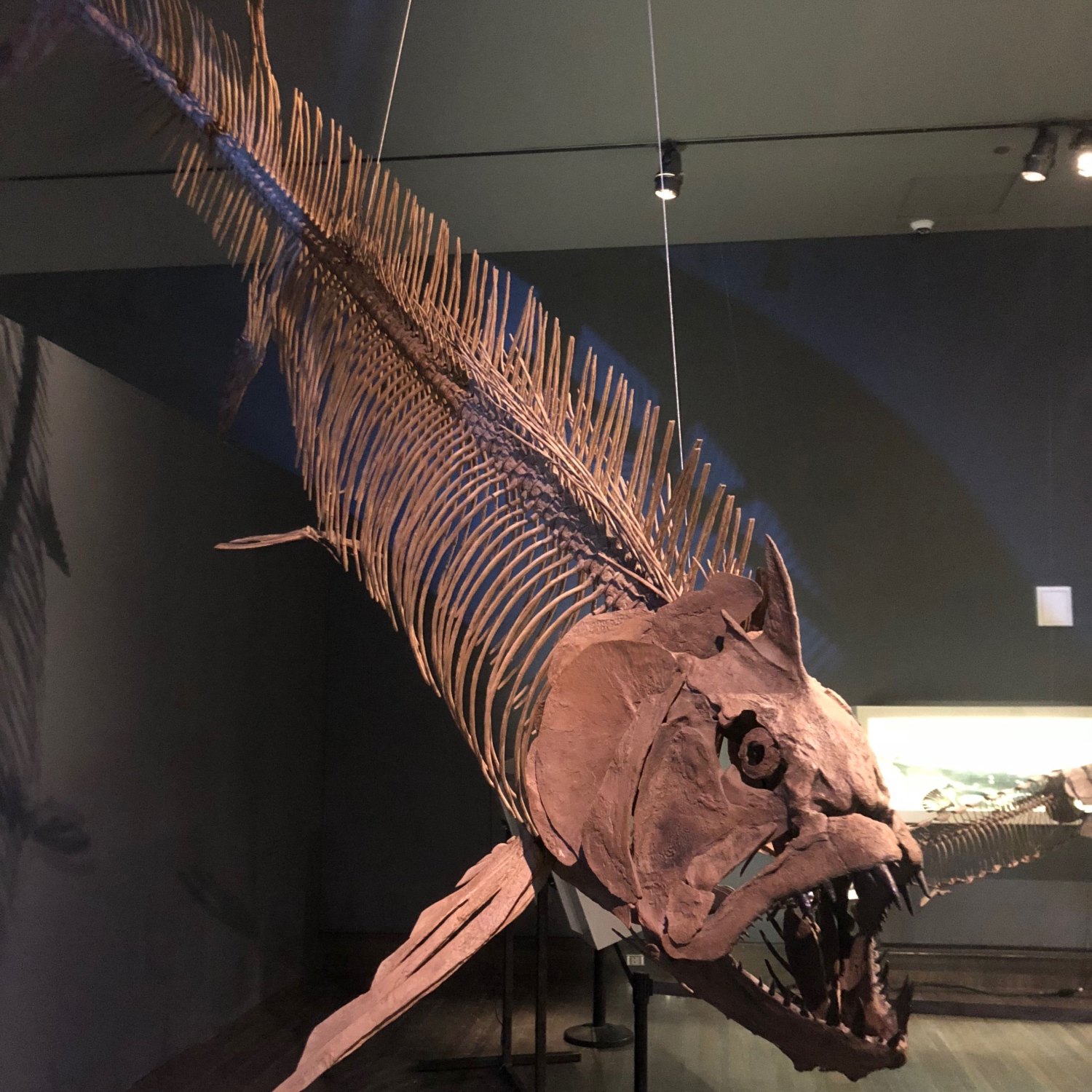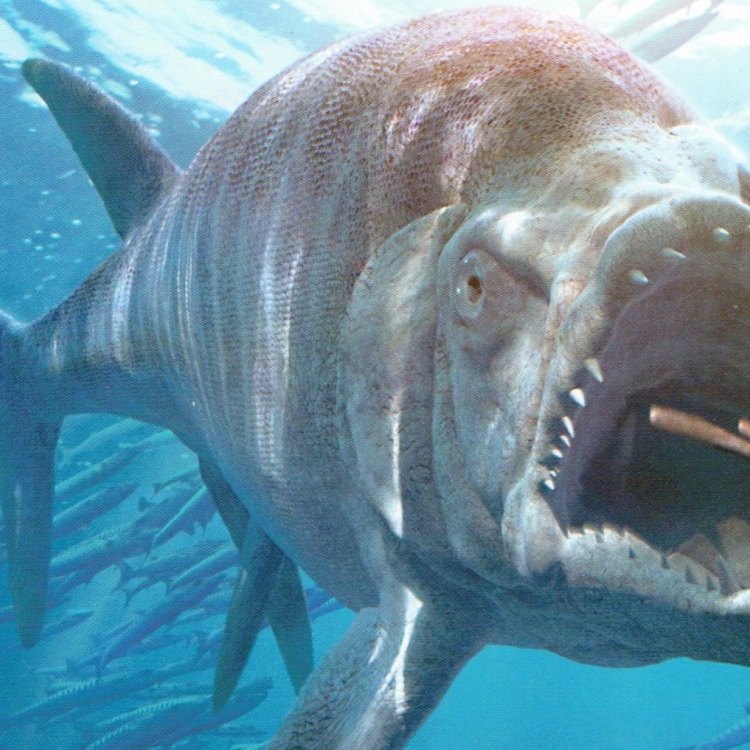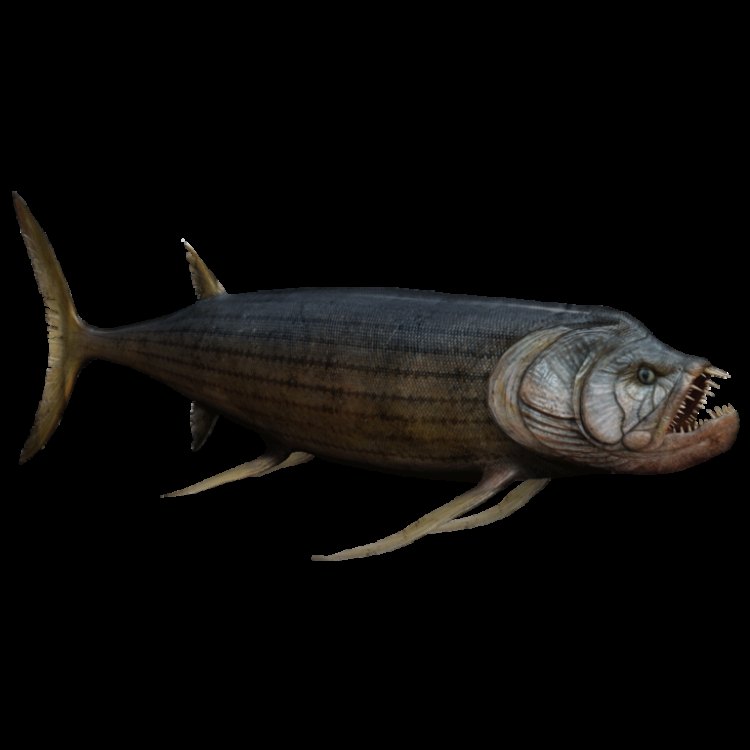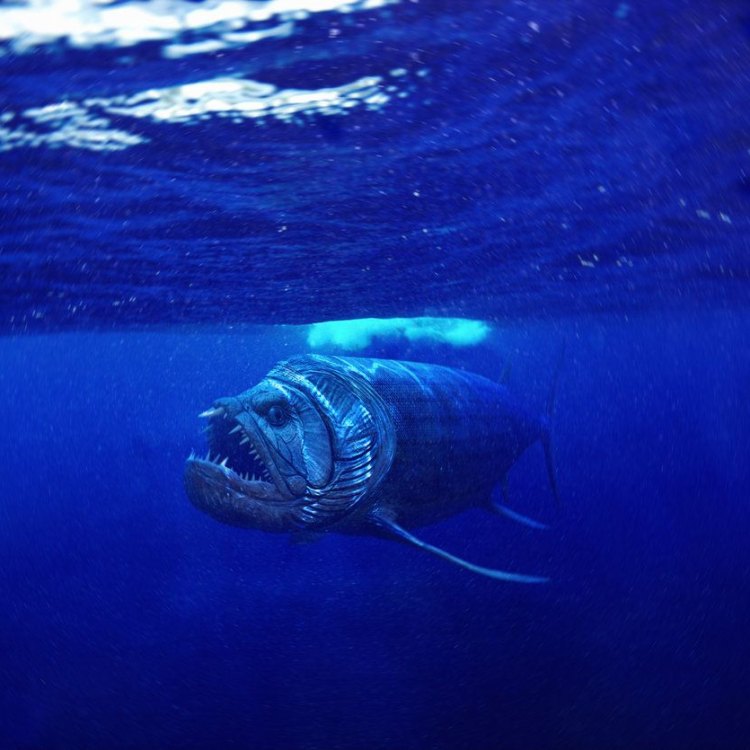
Xiphactinus
Up to 20 feet
Xiphactinus, an extinct fish from the Xiphactinidae family, thrived in the Western Interior Seaway. With a body shape that was elongated and streamlined, it could grow up to 20 feet in length. These impressive animals went extinct over 66 million years ago, leaving behind only their fossils to remind us of their once dominant presence in the ocean. #Xiphactinus #extinctanimals #westerninteriorseaway
Animal Details Summary:
Common Name: Xiphactinus
Kingdom: Animalia
Habitat: Marine
The Mighty Xiphactinus: A Fierce Predator of the Western Interior Seaway
The oceans and seas of the world have always been a source of fascination and mystery. With their vast depths and diverse inhabitants, there is always something new and exciting waiting to be discovered. One such creature that captured the attention of many researchers and explorers is the Xiphactinus.Known scientifically as Xiphactinus audax, this prehistoric fish was a fierce predator that inhabited the Western Interior Seaway of North America Xiphactinus. With an impressive length of up to 20 feet, this animal was a force to be reckoned with in the ancient seas. In this article, we'll dive deep into the world of the Xiphactinus and learn about its physical characteristics, behavior, and the environment it called home.
Classification and Habitat
The Xiphactinus belongs to the kingdom Animalia, phylum Chordata, and class Actinopterygii. Its order, Ichthyodectiformes, consists of extinct ray-finned fishes that were found in the marine environment. The Xiphactinus was part of the family Xiphactinidae, which includes other fish species such as Gillicus, Ichthyodectes, and Ichthyodectoides.This formidable fish lived during the late Cretaceous period, between 70 and 85 million years ago. During this time, a large inland sea called the Western Interior Seaway covered a significant portion of North America, separating the continent into two landmasses. This is where the Xiphactinus thrived, along with other marine creatures such as mosasaurs, plesiosaurs, and giant turtles.
Physical Characteristics
One of the most distinctive features of the Xiphactinus was its elongated and streamlined body shape Xenotarsosaurus. This allowed it to move quickly through the water, making it an efficient hunter. Its body was covered in small, overlapping scales that were dark blue-gray in color, providing excellent camouflage in the deep blue sea.At the center of its body, the Xiphactinus sported a pair of massive pectoral fins that helped it propel through the water with ease. Its head was large and elongated, with a mouthful of sharp, pointed teeth. Paleontologists believe that the Xiphactinus was also capable of swallowing prey nearly its own size, thanks to its stretchable jaw.
But perhaps the most striking feature of this fish was its dorsal fin, which ran along the entire length of its body. This fin was supported by a series of spiked bones, giving the Xiphactinus a powerful defense against potential predators.
Feeding Method and Behavior
As a member of the order Ichthyodectiformes, the Xiphactinus was a carnivorous fish that fed on smaller fish and marine invertebrates. Its preferred hunting method was to lie in wait for its prey and then lunge with great speed and force, using its sharp teeth to secure its meal.Paleontologists have found fossilized stomach contents of Xiphactinus that contained smaller fish and even other Xiphactinus. This indicates that these fish were apex predators, ruling the ancient seas with their impressive size and ferocious appetite.
Aside from its feeding behavior, not much is known about the Xiphactinus' social behavior. However, researchers believe that these fish were solitary creatures and only came together during the mating season.
Geographical Distribution and Country of Origin
The Xiphactinus inhabited the Western Interior Seaway, which extended from what is now the Gulf of Mexico to the Arctic Ocean. This ancient sea was a vast and diverse environment, with a variety of marine life that coexisted, hunted, and competed for resources.Within this marine ecosystem, the Xiphactinus was an important predator that helped maintain balance and biodiversity. Its wide geographical distribution highlights the widespread success of this species in the Western Interior Seaway.
As for the country of origin, the Xiphactinus was primarily found in the United States. Today, the fossils of this fish can be found in many U.S. states, including Kansas, Wyoming, and South Dakota.
Extinction and Legacy
Unfortunately, like many other prehistoric creatures, the Xiphactinus became extinct at the end of the Cretaceous period, around 66 million years ago. The cause of its extinction is still a mystery, but many scientists believe it was due to a catastrophic event, such as an asteroid impact or prolonged volcanic activity, that disrupted the Earth's life-sustaining systems.But even though the Xiphactinus has been extinct for millions of years, its legacy lives on. Its fossilized remains have been discovered and studied, providing valuable information about the ancient world and its inhabitants. The Xiphactinus has also sparked the imagination of many artists, writers, and filmmakers, becoming a popular subject in popular culture.
In Conclusion
The Xiphactinus was an impressive and formidable creature that ruled the ancient Western Interior Seaway. With its elongated and streamlined body, powerful fins, and sharp teeth, it was a successful predator and an essential part of the marine ecosystem.While the Xiphactinus may no longer swim in the seas, its story lives on through the fossilized remains that have been unearthed and studied by researchers. It serves as a reminder of the incredible diversity of life that once existed on our planet and the importance of preserving and protecting our delicate environments.

Xiphactinus
Animal Details Xiphactinus - Scientific Name: Xiphactinus audax
- Category: Animals X
- Scientific Name: Xiphactinus audax
- Common Name: Xiphactinus
- Kingdom: Animalia
- Phylum: Chordata
- Class: Actinopterygii
- Order: Ichthyodectiformes
- Family: Xiphactinidae
- Habitat: Marine
- Feeding Method: Carnivorous
- Geographical Distribution: North America
- Country of Origin: United States
- Location: Western Interior Seaway
- Animal Coloration: Blue-gray
- Body Shape: Elongated and streamlined
- Length: Up to 20 feet

Xiphactinus
- Adult Size: Unknown
- Average Lifespan: Unknown
- Reproduction: Unknown
- Reproductive Behavior: Unknown
- Sound or Call: Unknown
- Migration Pattern: Unknown
- Social Groups: Unknown
- Behavior: Unknown
- Threats: Extinction
- Conservation Status: Extinct
- Impact on Ecosystem: Unknown
- Human Use: Fossil display
- Distinctive Features: Large size and long jaws
- Interesting Facts: Xiphactinus was a fearsome predator of the Western Interior Seaway.
- Predator: Unknown

Xiphactinus audax
The Fearsome Predator: Xiphactinus and Its Unique Features
Deep in the ancient waters of the Western Interior Seaway, swam a creature that struck fear into the hearts of all other marine life. Its name was Xiphactinus, and it was a dominant fish that thrived in the prehistoric world. Today, all that remains of this formidable fish are fossils, but they reveal a creature unlike any other. From its immense size to its distinctive features, Xiphactinus stands out as a remarkable and unique species PeaceOfAnimals.Com.One of the most intriguing aspects of Xiphactinus is its size. While it's hard to determine the exact adult size of this fish, estimates place it at an impressive 20 feet long and weighing over 3,000 pounds. This makes it one of the largest bony fish ever known, dwarfing even modern-day predators like the great white shark. With its massive size, Xiphactinus had the advantage of being at the top of the food chain, preying on smaller fish, squid, and even other marine reptiles.
Despite being such a formidable predator, very little is known about the average lifespan of Xiphactinus. However, we do know that it lived during the Late Cretaceous period, approximately 86 to 65 million years ago. During this time, the Western Interior Seaway covered much of central North America, and Xiphactinus was a dominant species in these waters.
While we may never know the exact reproductive behavior of Xiphactinus, we can infer that it was similar to other fish of its time. Most likely, it laid eggs and went through a spawning process, producing numerous offspring to ensure the survival of its species Xenoposeidon. But what truly stands out about Xiphactinus is its unique reproductive behavior.
Unlike other fish, Xiphactinus is believed to have been an iteroparous species, which means it could reproduce multiple times throughout its life. This is a rare and advantageous trait, as it allows an individual to pass on its genes multiple times and increases its chances of surviving in a harsh and ever-changing environment. This unique reproductive behavior could be one reason why Xiphactinus was such a successful and dominant species during its time.
Interestingly, very little is known about the sound or call of Xiphactinus. However, it's safe to assume that as a dominant predator, it would have had some way of communicating with other members of its species. Perhaps it used low-frequency vibrations or visual displays to communicate important information, such as warnings or mating calls.
Similarly, little is known about the migration patterns of Xiphactinus. It's possible that this fish was a nomadic species, moving around in search of food and suitable breeding grounds. Alternatively, it may have preferred to stay in one area, especially if its food source was readily available. Without more evidence, it's challenging to determine the precise migration behavior of this ancient creature.
Another aspect of Xiphactinus that remains a mystery is its social groups and behavior. It's possible that Xiphactinus was a solitary hunter, stalking its prey alone and avoiding contact with other members of its species. However, it's also possible that it was a social creature, living in a group and hunting cooperatively. Without more information, it's challenging to determine the social behavior of this fish.
With little information about Xiphactinus's behavior and social groups, it's also challenging to determine the threats that it may have faced. However, it's believed that Xiphactinus became extinct during the Cretaceous-Tertiary extinction event, which wiped out a significant proportion of marine life. It's possible that this catastrophic event was the ultimate threat that led to the extinction of Xiphactinus.
Today, Xiphactinus is considered an extinct species and holds a conservation status of "extinct." Fortunately, we have been able to learn more about this remarkable fish through the discovery of fossils. These fossils have allowed us to piece together the puzzle of Xiphactinus's existence and learn more about its unique features and behavior.
One of the most distinctive features of Xiphactinus was its long jaws, filled with sharp teeth. Its jaws could open up to 90 degrees, allowing it to swallow larger prey whole. Its teeth were designed for gripping and holding onto prey tightly. This formidable skill made Xiphactinus a fearsome predator in the Western Interior Seaway, dominating the food chain for millions of years.
Despite being extinct for millions of years, Xiphactinus has left a lasting impact on our understanding of the prehistoric world. Its fossils have been discovered in various locations throughout North America, and some scientists even believe that Xiphactinus played a role in the evolution of bony fish.
Xiphactinus may be long gone, but its legacy lives on through the fossils that have been discovered and the knowledge we have gained about this remarkable creature. Today, its fossils are displayed in museums around the world, allowing us to marvel at this once-dominant predator and learn more about the diverse and fascinating species that once roamed the Earth.
In conclusion, Xiphactinus's unique features, such as its large size, distinctive jaws, and reproductive behavior, set it apart as a formidable predator and dominant species in the Western Interior Seaway. Its mysteries and enigmatic behaviors continue to fascinate scientists, and its legacy serves as a reminder of the diverse and ever-changing world that we live in.

The Mighty Xiphactinus: A Fierce Predator of the Western Interior Seaway
Disclaimer: The content provided is for informational purposes only. We cannot guarantee the accuracy of the information on this page 100%. All information provided here may change without prior notice.












